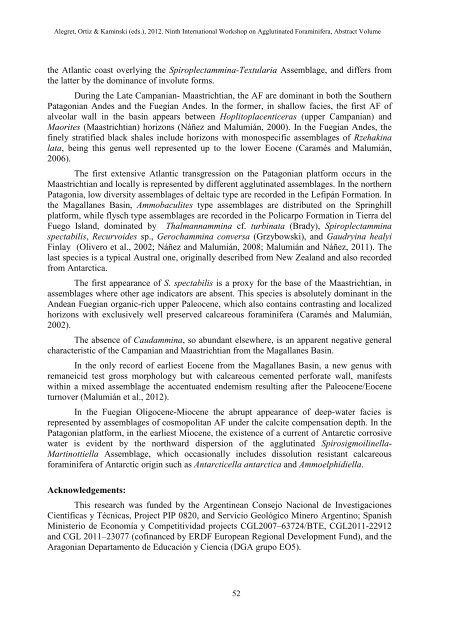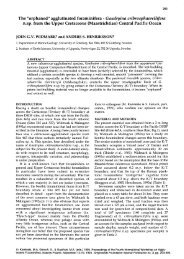Full Text | Download - Grzybowski Foundation - The ...
Full Text | Download - Grzybowski Foundation - The ...
Full Text | Download - Grzybowski Foundation - The ...
You also want an ePaper? Increase the reach of your titles
YUMPU automatically turns print PDFs into web optimized ePapers that Google loves.
Alegret, Ortiz & Kaminski (eds.), 2012. Ninth International Workshop on Agglutinated Foraminifera, Abstract Volume<br />
the Atlantic coast overlying the Spiroplectammina-<strong>Text</strong>ularia Assemblage, and differs from<br />
the latter by the dominance of involute forms.<br />
During the Late Campanian- Maastrichtian, the AF are dominant in both the Southern<br />
Patagonian Andes and the Fuegian Andes. In the former, in shallow facies, the first AF of<br />
alveolar wall in the basin appears between Hoplitoplacenticeras (upper Campanian) and<br />
Maorites (Maastrichtian) horizons (Náñez and Malumián, 2000). In the Fuegian Andes, the<br />
finely stratified black shales include horizons with monospecific assemblages of Rzehakina<br />
lata, being this genus well represented up to the lower Eocene (Caramés and Malumián,<br />
2006).<br />
<strong>The</strong> first extensive Atlantic transgression on the Patagonian platform occurs in the<br />
Maastrichtian and locally is represented by different agglutinated assemblages. In the northern<br />
Patagonia, low diversity assemblages of deltaic type are recorded in the Lefipán Formation. In<br />
the Magallanes Basin, Ammobaculites type assemblages are distributed on the Springhill<br />
platform, while flysch type assemblages are recorded in the Policarpo Formation in Tierra del<br />
Fuego Island, dominated by Thalmannammina cf. turbinata (Brady), Spiroplectammina<br />
spectabilis, Recurvoides sp., Gerochammina conversa (<strong>Grzybowski</strong>), and Gaudryina healyi<br />
Finlay (Olivero et al., 2002; Náñez and Malumián, 2008; Malumián and Náñez, 2011). <strong>The</strong><br />
last species is a typical Austral one, originally described from New Zealand and also recorded<br />
from Antarctica.<br />
<strong>The</strong> first appearance of S. spectabilis is a proxy for the base of the Maastrichtian, in<br />
assemblages where other age indicators are absent. This species is absolutely dominant in the<br />
Andean Fuegian organic-rich upper Paleocene, which also contains contrasting and localized<br />
horizons with exclusively well preserved calcareous foraminifera (Caramés and Malumián,<br />
2002).<br />
<strong>The</strong> absence of Caudammina, so abundant elsewhere, is an apparent negative general<br />
characteristic of the Campanian and Maastrichtian from the Magallanes Basin.<br />
In the only record of earliest Eocene from the Magallanes Basin, a new genus with<br />
remaneicid test gross morphology but with calcareous cemented perforate wall, manifests<br />
within a mixed assemblage the accentuated endemism resulting after the Paleocene/Eocene<br />
turnover (Malumián et al., 2012).<br />
In the Fuegian Oligocene-Miocene the abrupt appearance of deep-water facies is<br />
represented by assemblages of cosmopolitan AF under the calcite compensation depth. In the<br />
Patagonian platform, in the earliest Miocene, the existence of a current of Antarctic corrosive<br />
water is evident by the northward dispersion of the agglutinated Spirosigmoilinella-<br />
Martinottiella Assemblage, which occasionally includes dissolution resistant calcareous<br />
foraminifera of Antarctic origin such as Antarcticella antarctica and Ammoelphidiella.<br />
Acknowledgements:<br />
This research was funded by the Argentinean Consejo Nacional de Investigaciones<br />
Científicas y Técnicas, Project PIP 0820, and Servicio Geológico Minero Argentino; Spanish<br />
Ministerio de Economía y Competitividad projects CGL2007–63724/BTE, CGL2011-22912<br />
and CGL 2011–23077 (cofinanced by ERDF European Regional Development Fund), and the<br />
Aragonian Departamento de Educación y Ciencia (DGA grupo EO5).<br />
52



